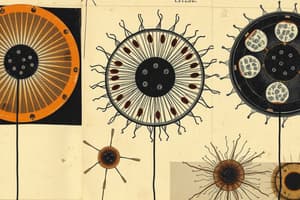Podcast
Questions and Answers
What is a key structural difference between eukaryotic flagella and bacterial flagella?
What is a key structural difference between eukaryotic flagella and bacterial flagella?
- Eukaryotic flagella are shorter.
- Eukaryotic flagella are covered by an extension of the cell membrane. (correct)
- Eukaryotic flagella contain no microtubules.
- Eukaryotic flagella are completely solid.
Eukaryotic cilia are larger than eukaryotic flagella.
Eukaryotic cilia are larger than eukaryotic flagella.
False (B)
What is the arrangement of microtubules in eukaryotic flagella and cilia called?
What is the arrangement of microtubules in eukaryotic flagella and cilia called?
9 + 2 arrangement
The outermost layer that comes into direct contact with the environment is called the __________.
The outermost layer that comes into direct contact with the environment is called the __________.
Match the following structures with their descriptions:
Match the following structures with their descriptions:
Flashcards
Eukaryotic flagella
Eukaryotic flagella
Flagella in eukaryotes are thicker, more complex, and covered by the cell membrane.
9 + 2 arrangement
9 + 2 arrangement
The structural organization of microtubules in flagella and cilia: nine pairs surrounding one pair.
Eukaryotic cilia
Eukaryotic cilia
Smaller, more numerous structures compared to flagella, similar in structure.
The Glycocalyx
The Glycocalyx
Signup and view all the flashcards
Cell wall of fungi
Cell wall of fungi
Signup and view all the flashcards
Study Notes
Eukaryotic Flagella and Cilia
- Eukaryotic flagella differ from bacterial flagella, being about ten times thicker and structurally more complex.
- They are covered by an extension of the cell membrane and are long, sheathed cylinders containing regularly spaced microtubules.
- Eukaryotic cilia are similar to flagella in structure but are smaller and more numerous.
- They are found only in a single group of protozoa and certain animal cells
Microtubules in Flagella
- Regularly spaced microtubules extend along the entire length of the flagellum.
- There's a 9 + 2 arrangement: nine pairs of microtubules surround a single pair.
- This 9 + 2 arrangement is also present in cilia.
The Glycocalyx
- The glycocalyx is an outermost layer directly contacting the environment.
- It's composed of polysaccharides and can appear as a network of fibers, a slime layer, or a capsule.
- It contributes to protection, adherence, and signal reception.
Cell Walls
- Protozoa and helminths lack cell walls.
- Fungal cell walls are rigid, providing structural support and shape.
- Their composition differs from bacterial and archaeal cell walls.
- A thick inner layer of polysaccharide fibers (chitin or cellulose) forms the core of the wall.
- A thin outer mixed glycan layer is on the exterior.
Studying That Suits You
Use AI to generate personalized quizzes and flashcards to suit your learning preferences.




